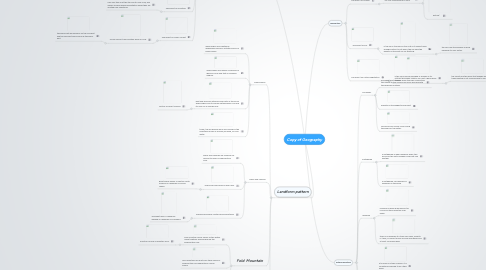
1. Effect of climate
1.1. The effect of latitude
1.1.1. The sun's ray is more intense near the equator, and it's less concentrated at the North Pole and the South Pole .
1.1.1.1. Polar climate
1.1.1.1.1. Has sever cool summer and short and cold winter for very long
1.1.1.2. Tropical climate
1.1.1.2.1. Is hot and wet.
1.1.1.3. Temperate climate
1.1.1.3.1. Is warmer in January than June
1.2. The effect of water bodies
1.2.1. When you are near a water bodies, at summer time it would be cooler and at winter time it would be warmer.
1.2.1.1. Maritime
1.2.1.1.1. Has a very nice climate,warm in winter and cool in summer.
1.2.1.2. Continental time
1.2.1.2.1. It's very hot at summer and very cold in winter.
1.3. The effect of moving air
1.3.1. at your home if you have a basement and you know is cooler than the main floor is because warm air is light and it rises.
1.3.1.1. The effect of desert climate
1.3.1.1.1. it would affect because of the hot air rises and returned it to the cloud and became rain.
1.4. The effect of mountain
1.4.1. Has very thin air at the top and it's very cold, and always receive heavy precipitation when they are located near coastlines.
1.5. The effect of ocean current
1.5.1. Ocean current can be either warm or cold.
1.5.1.1. the warm part would warm up the cold part and the cold part would cold up the warm part.
2. Landform pattern
2.1. shield region
2.1.1. shield region are created by widespread volcanic activity billions of years before.
2.1.2. shield region are largely composed of igneous rocks and that is solidified magma.
2.1.3. heat and pressure altered some parts of those old shield region and it formed metamorphic rock and it's also call a change rock.
2.1.3.1. picture of how it formed
2.1.4. today, the are heavily worn and carved by the relentless forces of erosion,like wind, ice and water.
2.2. plains and lowland
2.2.1. plains and lowlands are underlain by horizontal layers of sedimentary rock.
2.2.2. plains are board area of lever land.
2.2.2.1. great plains region of central North America is a example of a plain region.
2.2.3. lowlands are plains located along coastlines.
2.2.3.1. The great lake ST.Lawrence lowland is a example of a lowland.
2.3. Fold Mountain
2.3.1. Fold mountain forms slowly as two plates move together and bending up the sedimentary rock.
2.3.1.1. a picture of how a mountain form
2.3.2. fold mountains are built from thick layers of sedimentary rock deposited in ocean basins.
2.3.3. great mountain system form distinctive regions.
2.4. River system
2.4.1. Dendritic drainage
2.4.1.1. The mot common type
2.4.1.1.1. is a type of river system that looks like a tree-pattern and at the end it would joined the main river system.
2.4.2. Trellis drainage
2.4.2.1. Not a common as dendritic.
2.4.2.1.1. is a river system that flows around between soft rock and hard rock.
3. Agriculture
3.1. The effect of climate
3.1.1. if the place is too hot or too cold it's mot a good place to farm.
3.1.1.1. the place near the equates has a good climate.and it have lot's of rain.
3.1.1.1.1. E.g Mexico
3.1.1.2. picture:
3.2. The effect of soil
3.2.1. if the soil is too hard or too soft or it doesn't have enough nutria it's not good, the soil near the equator is the best soil for planting.
3.2.1.1. the soil near the equaker is good because it's very fertile.
3.3. The effect on natural vegetation
3.3.1. if the soil's had be polished or erodes or it's nutrient had been used all up if not a good pace to farm.
3.3.1.1. the forest and the place that already have trees planted is not a good place to farm.
3.3.1.1.1. E.g rain forest
4. natural disasters
4.1. volcanoes
4.1.1. a volcano blast happen when the pipe connecting the mantel to the surface becomes blocked with the hardened materiel.
4.1.2. Krakatoa is the biggest know blast.
4.1.3. volcanoes are usually occur along the edges of the plates.
4.2. Earthquake
4.2.1. a earthquake is when happens when two blocks of the earth suddenly slip past one another.
4.2.2. a earthquake can happens in anywhere in the world
4.3. landslide
4.3.1. landslide is when huge amount of rock from thee mountain rush down.
4.3.2. there is a landslide at a town call Frank, Alberta in 1903,74 million tonnes of rock slide down and at least 70 people died.
4.4. tsunami
4.4.1. a tsunami is a type of wave. it is sometimes referred to as a tidal wave.
4.4.2. tsunami is not relate to the pull of the moon's gravity and it's not like a storm surge.
4.4.3. an earthquake can cause tsunami by when is earthquake the plate will be one is up and one is below the other one, then when the water rush it will form a little or big wave.
4.5. tropical storm
4.5.1. typhoons
4.5.1.1. typhoons starts at pacific ocean.
4.5.2. a tornadoes is form when humid air raise up to the thunderstorm then winds begin to spiral around descending column of cold air then in will start to vortex.
4.5.3. tornadoes
4.5.3.1. tornadoes always starts at Mexico because there is lots of humid wind.
4.5.4. hurricanes
4.5.4.1. hurricanes starts at Africa and affect Caribbean and eastern north America.
4.5.5. cyclones
4.5.5.1. cyclones starts at the Indian ocean
